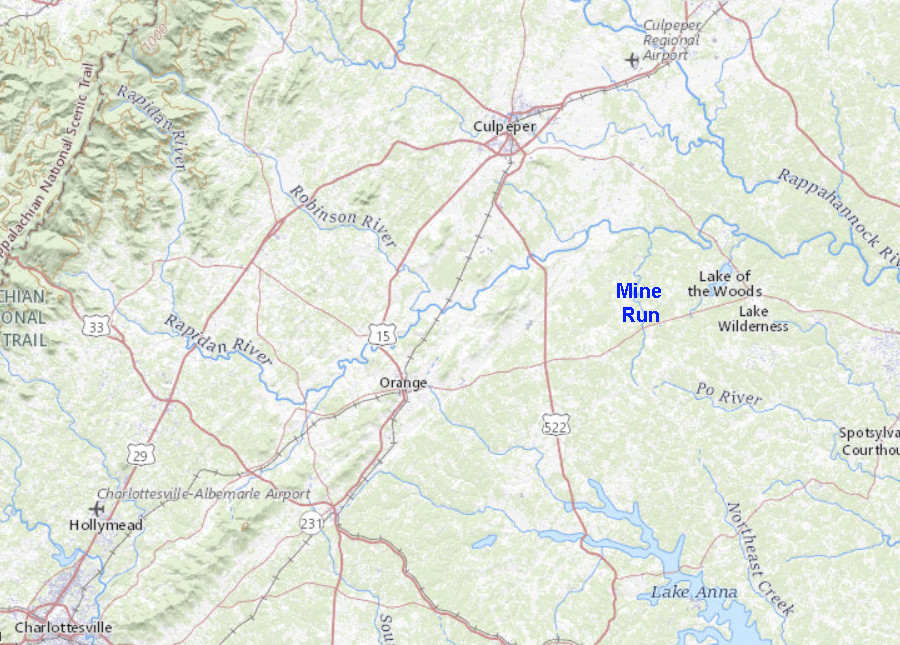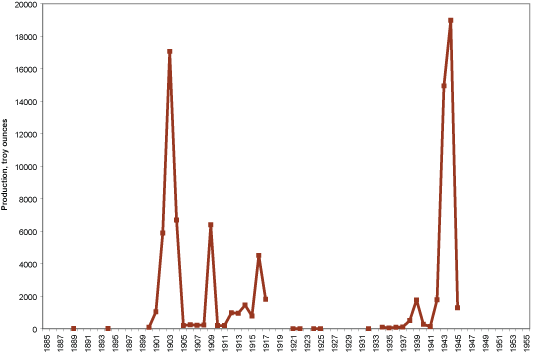
Governor Spotswood thought there might be silver on Mine Run
Source: ESRI, ArcGIS Online
English colonists who settled in Virginia were aware of the gold and silver that the Spanish extracted from South and Central America. Thomas Hariot reported that the colonists at Roanoke Island sailed 150 miles up the Roanoke River in 1585. They met Native Americans who reported that further inland:1
In 1670, John Lederer explored southwest from Fort Henry on the Appomattox River and reached the town of Ushery in the Piedmont of North Carolina. The residents there noticed the silver pommel on the handle of his sword, and told him that the rival tribe living on the other side of "Lake Ushery" had hatchets made of silver. The residents also told him that the women of the tribe were warriors who fired arrows over the heads of their husbands at their enemies; they may have entertained themselves by telling tales to the stranger.
Lederer acquired "Some pieces of Silver unwrought" at Ushery, in part to prove he had reached that location. He claimed in his journal that the Spanish silver mines were a jouney of just several days away from Ushery. He did not try to visit them, fearing he would be perceived as a spy and held captive.2
The early colonists failed to find precious metals in Virginia, but exploration continued as settlement moved west.
In 1704-06, Frantz Ludwig Michel explored the Potomac River and the Shenandoah River upstream of Harpers Ferry. He claimed to have discovered silver deposits. He returned to Europe in order to recruit Swiss and German settlers who could develop mines, but in 1710 ended up sailing to Carolina with Baron Christoph von Graffenried to develop land claims at New Bern.
Michel died in Carolina during the Tuscarora rebellion. Baron Christoph von Graffenried went into debt and lost control of the colony at New Bern, then came to Virginia in 1712 to search for silver ore along the Potomac River near what is now Harpers Ferry. Graffenried was broke when he returned to Europe.
In London, he encountered a group of German iron miners. They were there because Graffenried and Michel had sent a recruiter in 1710 to the town of Siegen. Graffenried and Michel planned to return from New Bern with profits from transporting settlers there, then organize a new silver-mining settlement in Virginia along the Potomac River.
Graffenried and Virginia's colonial agent, Nathaniel Blakiston, arranged to place the miners on a ship to Virginia, promising that Governor Spottswood would pay for their costs. The governor was surprised when the immigrants arrived, but he paid the ship captain 150 pounds and sent the immigrants on the Rapidan River as his indentured servants. The first Germanna colony lated four years, and never mined for silver (or iron).
there was an appearance of a silver mine by it."3

Governor Spotswood thought there might be silver on Mine Run
Source: ESRI, ArcGIS Online
Silver ore in Virginia is associated with other metallic ores, and gold ore in the Piedmont includes 10% silver. Production in Virginia was primarily as by-product from extraction at lead-zinc and copper deposits. The first silver production was in 1885, and the last in 1945. Over those 60 years, about 90,000 troy ounces was produced in Virginia.4
An examination in 1984 of the Buck Mountain mine in Amherst County included a sample that assayed at 5.4 ounces of silver per ton, plus an additional 0.07 ounces of gold per ton. The site had a 14-inch thick zone of:5

silver production in Virginia lasted between 1885-1945
Source: Virginia Department of Mines, Minerals, and Energy, Silver in Virginia